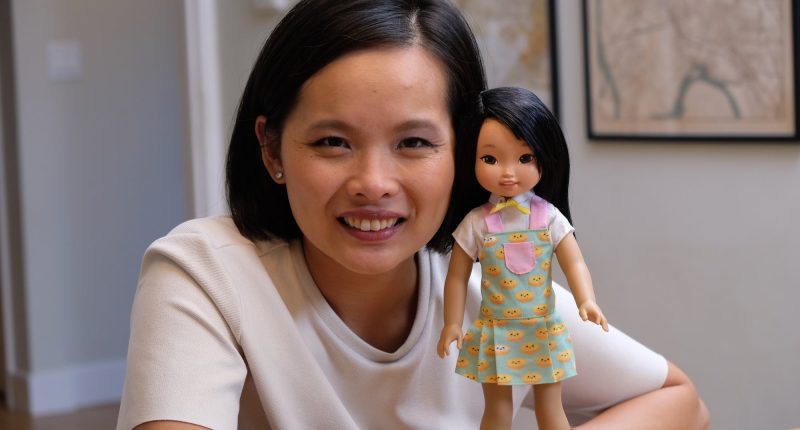In 2022, Elenor Mak, now founder of doll company Jilly Bing, was busy balancing her business development role at a healthcare company and raising her 2-year-old and 4-year-old children. Back then, she “was definitely not looking to start” a side hustle. She’d founded an ecommerce fashion company in the past and knew what it took to get a business up and running. But that changed when her young daughter Jillian began playing with stuffed animals and dolls.
 Image Credit: Courtesy of Jilly Bing. Elenor Mak.
Image Credit: Courtesy of Jilly Bing. Elenor Mak.
“It reminded me of my own childhood,” Mak tells Entrepreneur. “You’re playing with dolls; you’re trying to make sense of the world. She was bossing her dolls around, like, ‘Eat your dinner. Wash your hands.’ Acting like a mom. Not in those words, but at age two, sort of using those words, simpler versions of those words.”
Related: How to Go From Side Hustle to 7-Figure Business and Beyond, According to 3 Women Who Did It
One day, Mak’s mother gave her granddaughter a “beautiful blonde, blue-eyed doll.” When Mak asked her why she’d chosen that doll instead of one that looked like her daughter, her mother said, “It was the prettiest one on the shelf.” Despite knowing her mother meant well, Mak found those words “so heavy,” a reminder of her own experience with lack of representation as a child.
“They gave them an Asian name, like Ling, or like a bad haircut. It was so shocking and disappointing.”
Mak decided to buy her daughter a doll that looked like her and figured it would be a straightforward process: Because I live in San Francisco, and it’s 2022. But it wasn’t. Her local toy store didn’t have one. Neither did the second she visited. Or the third. The toy aisles at major retailers like Target and Toys”R”Us seemed as though they “had not evolved” since Mak was a kid, nearly four decades before.
“There were just rows and rows of Caucasian dolls, brunettes, and then at the very end of the aisle, you would have these dolls that I think were intended to be Asian because they were holding a panda bear,” Mak recalls. “They gave them an Asian name, like Ling, or like a bad haircut. It was so shocking and disappointing.”
Mak looked to Asia for more options, but asking her relatives what they could find only turned up “Eurasian-looking dolls,” she says, adding that “dolls largely represent what society thinks is beautiful, and in Asia, what’s beautiful is still the Caucasian sort of features.” Mak remembered wishing she were beautiful like the dolls she had growing up, and “her mommy bear instincts” kicked in — she was determined to get her daughter a doll that looked like her, even if she had to make it herself.
How hard could it be? “It’s really hard — really hard — to make a good doll.”
Mak Googled “how to make a doll,” and armed with an MBA from Harvard Business School and her “strong business background,” she got to work on a side hustle that would shake up the $40 billion toy industry. Although she admits the creative component wasn’t where she excelled (“My 6-year-old son is a better artist than me,” she quips), she had a clear vision when it came to the business side and the potential for major demand: “The Asian American population is one of the fastest-growing — we’re 7% of the country’s population.”
And how hard could it be to make a doll in an age where we’re churning out Teslas and developing AI? She recalls thinking. As it turns out, “it’s really hard — really hard — to make a good doll,” Mak says. Fortunately, her business background helped her develop an essential “superpower“: “finding really good people.” Mak did cold outreaches to Asian designers at large toy brands and leveraged her own extensive network to connect with professionals who could bring the dream to life.
 Image Credit: Courtesy of Jilly Bing. Elenor Mak and her daughter Jillian with the Jilly doll.
Image Credit: Courtesy of Jilly Bing. Elenor Mak and her daughter Jillian with the Jilly doll.
By June 2022, they had their team of four. Mak conducted a lot of research over the next several months, speaking with Asian families and looking at photographs of kids and dolls to really try to understand what parents wanted. “It’s not just about saying, ‘Oh, this doll’s Asian,'” Mak says. “But what mattered to them? What were the features? What were the backstories?” In December of that year, the prototype for Jilly Bing, named for Mak’s daughter Jillian and the Chinese word for cookie, “bing gan” (Jillian’s first word), was ready to share with the world.
“Adult women would write in and be like, ‘Oh my gosh, it’s like healing for my inner child.'”
Jilly Bing started shipping dolls in August 2023 — and sold out of its stock of 2,000 within six weeks. Greta Gerwig’s blockbuster hit Barbie had also put the spotlight on dolls that summer, “opening up the national conversation” and presenting “an opportunity for us to change the narrative for not just our Asian children, but all children,” Mak says. At that point, Mak realized the “high-risk, high-effort” passion project she’d worked on as a side hustle for the past couple of years — taking late-night business calls after her kids were asleep and balancing it all with her full-time day job — would benefit from her undivided attention.
Jilly Bing also appeared on the Today show around that time, and the positive response was “overwhelming.” “Adult women would write in and be like, ‘Oh my gosh, it’s like healing for my inner child. Life would have been so different if I had a doll that looked like me growing up,'” Mak says. “Even non-Asian parents writing [in to say], ‘Oh my gosh, I think my kids should have dolls that look like their friends.'”
By early this year, Jilly Bing was on shelves at Macy’s; the retailer reached out after the Today segment. “It’s a company I grew up with,” Mak says, “so it was just really wonderful that they saw the value of Jilly Bing so early on.” Jilly Bing is also part of Macy’s Mission Every One initiative, which has committed $5 billion of spending through 2025 to its people, partners, products and programs “to create a more equitable and sustainable future.”
Related: How This Doctor-Turned-Entrepreneur Is Trying to Change the World Through Play
“Seeing the kids’ reactions to having a doll that looks like them keeps me going [more than] everything else.”
To date, Jilly Bing has sold approximately 5,000 dolls, Mak says. At $68 apiece, that’s more than $300,000 in sales.
And Mak’s favorite part about running her business? That would be the testimonials from her young customers. “It’s seeing the photos,” Mak says. “And hearing the stories [from them] — and my own daughter — saying, ‘She looks like me. She has black hair like me.’ [And] little Asian boys saying, ‘She’s beautiful like my mama.’ It’s just seeing the kids’ reactions to having a doll that looks like them that keeps me going [more than] everything else.”
 Image Credit: Courtesy of Jilly Bing.
Image Credit: Courtesy of Jilly Bing.
Mak had to “trust her gut” to start the side hustle turned full-fledged business that’s leaving its mark on the toy industry and beyond, and she looks forward to building the brand out in the years to come.
“I am most excited about being able to create characters,” Mak says. “We started to branch into comics because it’s a doll, but we’re starting to create the stories. I’ve got a vision of a whole cast of Asian American characters that actually reflect what Asian America looks like today. We have mixed Asian children, you have boys, you have Southeast Asian. Jilly’s our first doll, so I’m excited to grow and introduce the world to the rest of Jilly Bing’s friends.”









